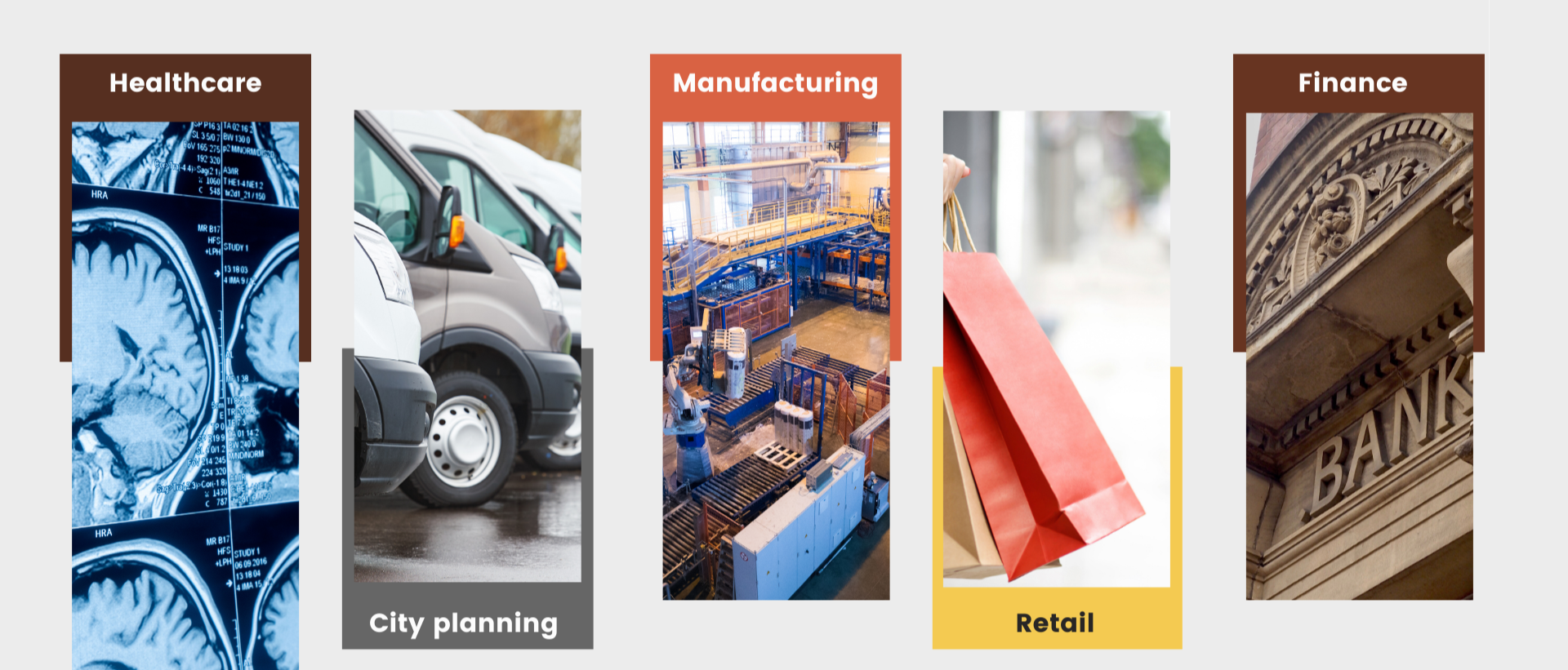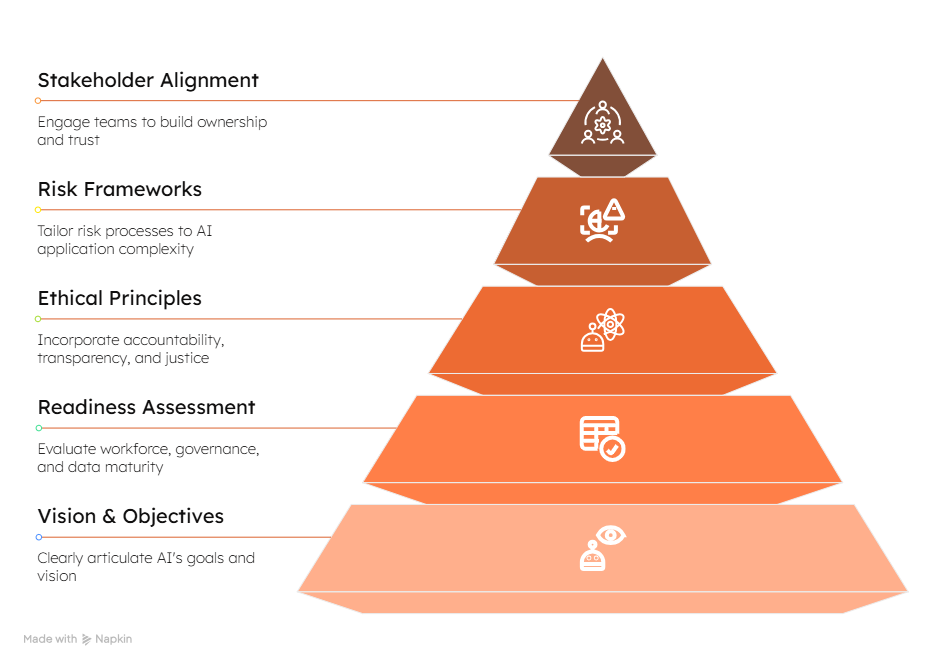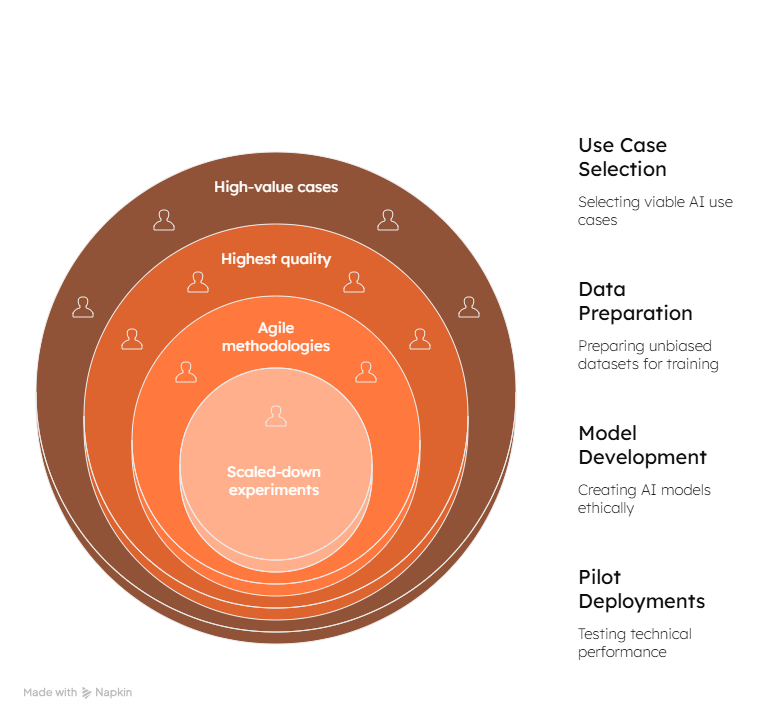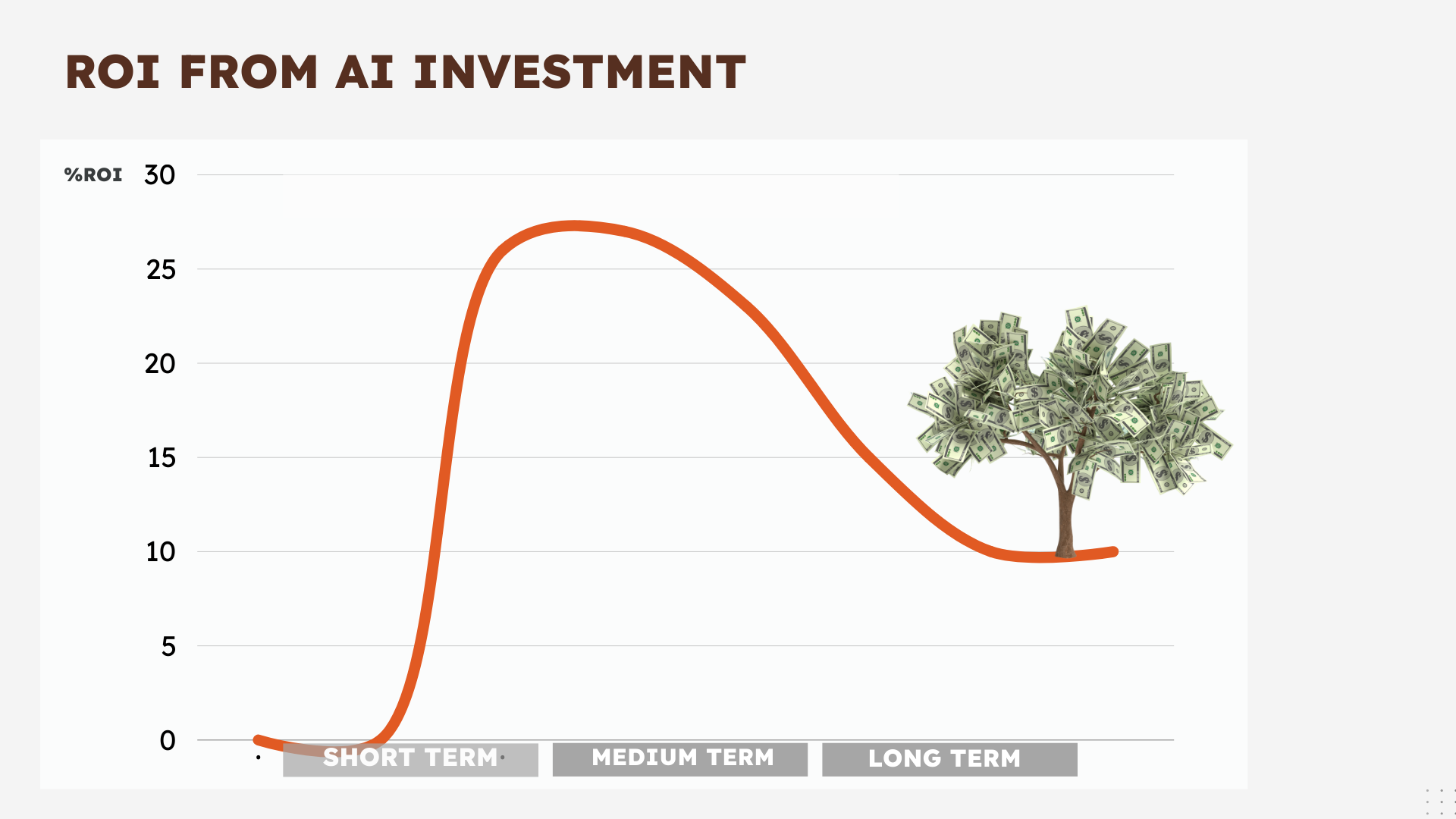AI Expert Change Management
AI Adoption
Contact us
Our Approach to Culture & Change Management
Introduction to Service Offering
Project success in today’s constantly changing digital economy relies not just on new technology implementation but also on an organization’s ability to absorb, accommodate, and prosper amidst change. AI change management bridges the gap between technology adoption and human capital, ensuring that innovation delivers measurable and durable value.
At T3, we drive change through the combination of cutting-edge AI capabilities and experienced management knowledge. As trusted AI transformation consultants, we help reduce implementation risk and enhance employee engagement. We approach this as a strategy with which companies embrace that people, rather than technology, drive change.
Key Advantages of AI Adoption for Businesses
By streamlining routine tasks, artificial intelligence adoption increases workers’ motivation and frees up employees to focus on more crucial, strategic tasks. As an AI transformation consultant, we help organizations develop a culture of continuous learning and innovation by offering the latest technology and artificial intelligence (AI) functionality to teams, boosting team morale and retention.
The stakeholders’ confidence is boosted by having ethical and transparent AI policies, such as regulators and investors, which is a key aspect of successful artificial intelligence adoption. By demonstrating maturity and resiliency, ethical AI use helps businesses enter new markets, make strategic partnerships, and address shifting regulatory needs.
AI provides faster, precise, and customized services by personalizing consumer interactions at scale.
Predictive analytics, intelligent chatbots, and recommendation engines drive deeper customer loyalty, satisfaction, and lifetime value.
AI enhances workflows by speeding routine decision-making, reducing errors, and simplifying procedures.
Through its help, firms can achieve significant cost savings and productivity gains, reallocating resources to initiatives for essential growth.
AI creates large databases into meaningful insights, which facilitate data-driven, real-time decision-making.
Through this, leaders gain improved foresight, risk assessment, and scenario planning capabilities, which reduce uncertainty and enhance strategic innovation.
In this modern era, AI can develop whole new products, services, and business models through subscription platforms and intelligent ecosystems.
Organizations can disrupt established sectors and establish new value chains by inventing more quickly and efficiently.
Early and ethical AI adoption distinguishes companies from their slower-moving peers.
It enables faster market entry, stronger customer propositions, and superior operational models, positioning organizations as industry leaders.
Positive Impact
AI ApplicationsApplications across Sectors
Find Applications in Your Industry
The scope of AI is not only limited to one sector, but it reshapes value chains, customer relationships, and operational models in each sector.
In our T3, we make certain AI adoption strategies of the specific dynamics, regulatory requirements, and opportunities unique to your market.
At T3, we run an 8-week AI Efficiency Sprint to help companies find real, tangible savings through smarter use of AI. That might mean automating time-consuming tasks, improving how teams make decisions, or reducing waste in everyday operations. But we don’t just chase efficiency for its own sake—we work closely with leadership teams to make sure AI is supporting their goals, not disrupting what already works. The result? Savings you can see, without the headaches you might expect. Thoughtful, practical, and always grounded in what’s right for your business.
Examples of Sector-Specific Applications Include
Change Isn’t the Challenge. Poor Change Execution Is.

Artificial intelligence (AI) is driving innovation across multiple sectors, transforming how businesses operate and deliver value, with measurable impact on productivity, efficiency, and profitability. According to PwC, AI could contribute up to $15.7 trillion to the global economy by 2030, with $6.6 trillion coming from increased productivity and $9.1 trillion from consumption-side effects.
AI-based risk management, anti-fraud, customized wealth management, cybersecurity, credit scoring, sentiment analysis, legal & complaince, complaints handling, accounting, deployment testing, portfolio mangement, reporting, operational resilience, marging optimisation, and automated regulatory compliance (e.g., RegTech).
Clinical decision support, intelligent drug discovery, personalised care, clinical documentation, trials, predictive patient therapy, and optimization of hospital and lab operations.
Supply chains augmented with AI, hyper-Personalized Marketing, content generation to suport e-commerce, VR/AR, dynamic pricing, predictive inventory management, and extremely personalized marketing.
Energy trading optimized with AI, cybersecurity, enhanced operation, third party risk management, smart grid management, carbon footprint analysis, and predictive maintenance of infrastructure.
Automation of citizen services, fraud detection, third party risk management, operational resilience, complaints handlings, reporting, intelligent urban infrastructure management, and the enhancement of security and defense intelligence.
Robust supply chains, digital twins, LLM applications, AI-based robotics, predictive quality control, and smart production lines that enable customization.
Next-generation service creation, RAN, AI led customer services, predictive maintenance, churn prediction for customers, network optimization, and AI-powered cybersecurity.
Personalized client services, legal research, document drafting and analysis, client communication, risk scoring, automated contract analysis, and intelligent document discovery.
Irrespective of whether your company is in financial services, manufacturing, health care, technology, or professional services, having a well-defined AI adoption strategy is not just an enhancement, it is a catalyst for reimagining how value is created and delivered
T3 works with you to identify high-impact use cases, create customized adoption plans, and ensure the AI integration is ethical, scalable, and sustainable.

Strategic AI Adoption Framework
1. Foundation
At the foundation stage, we lay out the operational, ethical, and strategic groundwork for AI projects.
Establish Vision and Objectives: Clearly articulate the vision and objectives of AI, such as the development of the customer experience and operations improvements.
Organizational Readiness Assessment: Look at workforce competence, governance structures, technology infrastructure, and data maturity.
Set Ethical Principles: From the outset, include accountability, responsibility, transparency, and justice in the design of AI.
Develop Risk Frameworks That Are Fit For Purpose: Tailor risk and compliance processes to the type, scope, and complexity of the intended AI application.
Stakeholder Alignment: Engage leadership and cross-functional teams early to build ownership and trust, a critical component of sustainable AI adoption strategy implementatio
2. Implementation
- This involves several steps: Creating, developing, and testing AI solutions in a controlled, supervised environment is the primary objective of this phase.
- Use Case Selection: Select high-value, viable AI use cases based on their ethical risk and business affect scores.
- Data Preparation: Take care to use the highest quality, unbiased, and compatible datasets for model training.
- Model Development and Testing: Use agile methodologies, ethical norms, and human-centered design to create AI models.
- Pilot Deployments: Execute sandbox pilots, or scaled-down experiments, to test technical performance and societal effects.
- Conduct human-in-the-loop testing, explainability evaluations, and bias audits as part of ethics and compliance checks.


3. Productionization
The shift from concept-of-proof to enterprise-class deployment requires clear and robust operational scalability.
Scalable Architecture Deployment: Implement stable, modular designs that allow for continuous learning and growth, e.g., MLOps pipelines.
Monitoring and Feedback Loops: Implement drift detection mechanisms, ongoing bias evaluation, and real-time AI output monitoring.
Employee Enablement: Educate frontline workers and business users in using AI technologies ethically and confidently.
Management of Change: Implement AI cautiously into processes to ensure a seamless, value-added, and people-oriented adoption process.
Change Management: Implement AI cautiously into processes to ensure a seamless, value-added, and people-oriented adoption.
DOWNLOAD AI ADOPTION GUIDELINE
Get your free copy of AI Adoption Guideline
Culture and Change Management Latest Stories
We partner with organizations across the private and public sectors to spark the behaviors and mindset that turn change into value. Here’s some of our work in culture and change.
Our Impact on AI Adoption
91% of top firms are already betting big on AI.
48% of EU companies can’t scale AI due to lack of skills.
33% AI spend in UK finance, compliance, KYC, and fraud are top targets.
25% efficiency boost in year one for AI-integrated businesses.
Only 3% have proper AI risk frameworks, the rest are flying blind.
AI-native firms grow 50% faster than the pack.
WHO DOES IT IMPACT?
All firms looking to reduce cost
Asset Managers
Banks
Commodity House
Fintechs
Services we Provide

Identifying Use Cases
- Evaluate your organization's technology, data, and organizational readiness for adoption of AI.
- Identifying AI Use Cases
- Developing a Responsible AI Strategy
- Engage leadership teams and influencers early on to build respect and shared purpose.

Human-Centered Design Implementation
- Design AI adoption programs that prioritize employees' needs, empowerment, and trust.
- Discover, refine, and pilot low-risk, high-value AI use cases.
- Ensure your AI initiatives are fueled by safe, compliant, and bias-monitored datasets.
- Training & AI Literacy Initiatives

Scaling AI Throughout the Organization
- Take advantage of leading-edge MLOps and DataOps practices to deploy secure, scalable, and sustainable AI models.
- Use AI-powered dashboards to track adoption, usage patterns, and pockets of resistance.
- Streamline processes to encourage innovation, value creation inc. collaboration between humans and AI.
- Customized engagement strategies to create buzz and respond dynamically to issues.

Permanent Assurance
- Monitoring of AI's impartiality, transparency, and bias, and following evolving guidelines (e.g., UK White Paper, EU AI Act).
- Reviews for performance improvement
- Regulatory Reporting and Alignment with ESG
- Resilience and Incident Response Planning
Frequently Asked Questions
Change management is augmented by artificial intelligence (AI) to predict the mood of employees, identify resistance points, personalize messaging, help with training programs, and track acceptance metrics in real time. It accelerates implementation, enhances decision-making, and facilitates data-driven customization of change plans.
No, AI will assist change managers but not replace them. Human leadership is still needed to manage emotions, build trust, and work through complex organizational dynamics during transition, even as AI can automate administrative tasks, reveal insights, and suggest actions.
Artificial intelligence (AI) for change management refers to the application of AI techniques, including machine learning, natural language processing, and predictive analytics, to aid in decision-making, communication, risk management, and employee engagement in transformation efforts.
- Understand business priority
- Assess the saving & pain point by engaging domain leads across business units (repetitive process, error prone, high data volume, bottlenneck in decision making etc.)
- Apply capability mapping (pattern recognition, NLP, Computer Vision genAI)
- Prioritise with an AI Scoring matrix
- Prototype & test
If you want truly to understand something, try to change it.
Kurt Lewin
Want to hire
Change Management Expert?
Book a call with our experts
Contact



